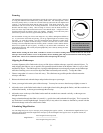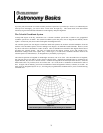32
Let’s say, for example, you are using the 40mm Plossl eyepiece. To determine the magnification you simply divide the focal
length of your telescope (the C8-S for example has a focal length of 2032mm) by the focal length of the eyepiece, 40mm.
Dividing 2032 by 40 yields a magnification of 51 power.
Although the power is variable, each instrument under average skies has a limit to the highest useful magnification. The general
rule is that 60 power can be used for every inch of aperture. For example, the C8-S is 8 inches in diameter. Multiplying 8 by 60
gives a maximum useful magnification of 480 power. Although this is the maximum useful magnification, most observing is
done in the range of 20 to 35 power for every inch of aperture which is 160 to 280 times for the C8-S telescope.
Determining Field of View
Determining the field of view is important if you want to get an idea of the angular size of the object you are observing. To
calculate the actual field of view, divide the apparent field of the eyepiece (supplied by the eyepiece manufacturer) by the
magnification. In equation format, the formula looks like this:
Apparent Field of Eyepiece
True Field =
Magnification
As you can see, before determining the field of view, you must calculate the magnification. Using the example in the previous
section, we can determine the field of view using the same 40mm eyepiece. The 40mm Plossl eyepiece has an apparent field of
view of 46°. Divide the 46° by the magnification, which is 51 power. This yields an actual field of .9°, or nearly a full degree.
To convert degrees to feet at 1,000 yards, which is more useful for terrestrial observing, simply multiply by 52.5. Continuing
with our example, multiply the angular field .9° by 52.5. This produces a linear field width of 47 feet at a distance of one
thousand yards. The apparent field of each eyepiece that Celestron manufactures is found in the Celestron Accessory Catalog
(#93685).
General Observing Hints
When working with any optical instrument, there are a few things to remember to ensure you get the best possible image.
• Never look through window glass. Glass found in household windows is optically imperfect, and as a result, may vary in
thickness from one part of a window to the next. This inconsistency can and will affect the ability to focus your telescope.
In most cases you will not be able to achieve a truly sharp image, while in some cases, you may actually see a double image.
• Never look across or over objects that are producing heat waves. This includes asphalt parking lots on hot summer days or
building rooftops.
• Hazy skies, fog, and mist can also make it difficult to focus when viewing terrestrially. The amount of detail seen under
these conditions is greatly reduced. Also, when photographing under these conditions, the processed film may come out a
little grainier than normal with lower contrast and underexposed.
• If you wear corrective lenses (specifically glasses), you may want to remove them when observing with an eyepiece
attached to the telescope. When using a camera, however, you should always wear corrective lenses to ensure the sharpest
possible focus. If you have astigmatism, corrective lenses must be worn at all times.


















